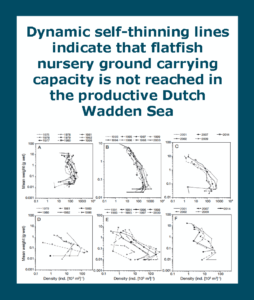We tested the hypothesis that flatfish nursery ground carrying capacity is not being reached for juvenile flatfish populations in the productive Balgzand intertidal (Dutch Wadden Sea). Dynamic self-thinning lines (the logarithmic relationship between the annual development of population density and mean individual weight) were estimated over the period 1975–2019, whereby a slope of –4/3 would indicate that carrying capacity was reached. In 0-group plaice Pleuronectes platessa L., a decrease in slope occurred from –2.69 on average in the 1980s to –0.81 in the 2010s. In 0-group flounder Platichthys flesus (L.), slopes increased from –0.98 in the 1980s to –1.77 in the 2010s. These slopes indicated that flatfish nursery ground carrying capacity was not reached at the Balgzand intertidal. This finding is in contrast to British bays, likely because of lower benthic food biomass in British bays (few g dry mass m–2) compared to Balgzand (tens of g dry mass m–2). Interannual differences in the slope of the dynamic self-thinning lines at Balgzand reflected changes in density during the season. From 1975–2019, the average daily instantaneous rate of change in 0-group flounder reflected mortality and was about 0.042 d–1 but with large interannual variations. In 0-group plaice, the rate of change in density was 0.020 d–1 in the 1970s, also reflecting mortality, but increased over time due to increased emigration. Dynamic self-thinning lines can be used to analyse flatfish nursery ground carrying capacity; however, in many flatfish nursery grounds, carrying capacity will presently not be reached.
